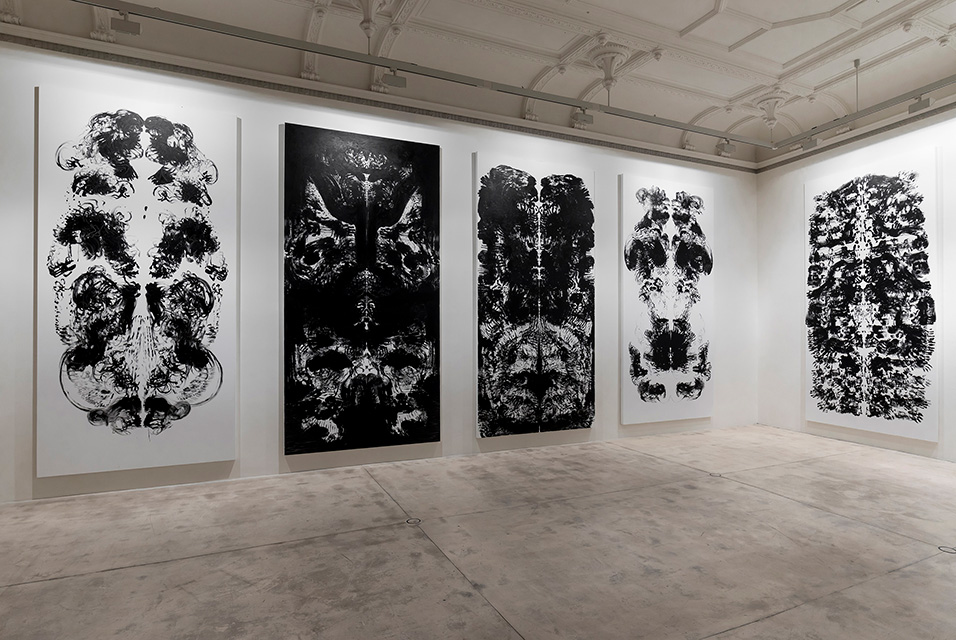Galerie Krinzinger opens exhibition devoted to Mark Wallingers paintings

artdaily_VIENNA.- Mark Wallinger, born 1959 in Chigwell, Essex, is one f the most important artists of his generation. Widely known for his sculpture Ecce Homo, the first sculpture presented at the fourth plinth at Trafalgar Square in 1999, also exhibited in the British Pavilion at the 49th Venice Biennale in 2001 as well as in a solo exhibition at the Secession in 2000 in Vienna. In 2007 he won the Turner Prize for his installation State Britain.
The exhibition, entirely devoted to his paintings, is the artist’s third solo show at Galerie Krinzinger. Upside Down Inside Out Back to Front brings together paintings made since 2015, incorporating three distinct, but related bodies of work, entirely hand-made and related to the proportions of the artist.
The id Paintings (2015/2016) are black-and-white monochromes that grew out of the extensive Self Portrait series (exhibited at Krinzinger in 2013). Each canvas is the width of the artist’s span or height (180cm), by double height (360cm). They mark a significant shift from the painted ‘I’ to ‘I paint’.
These performative works follow the traces of the artist - both hands working simultaneously to achieve symmetry on the upright canvas. The painting is flipped halfway through the process and thenceforth there is a dialogue for the other half to take part in. These pieces bear some resemblance to the psychological Rorschach test: the standard set of symmetrical ink blots of different shapes and colours presented one by one to a subject who is asked to describe what they suggest or resemble. Recognition of figures is a reflection of our own desires and predilections, a mapping of the territory. We invite your introspection. You are implicated.
Perhaps any mark when met with its mirror image, twin or double, has authority or meaning. One senses the process of making in more than purely visual terms because everything is pointing to active participation, something felt, experienced as empathy, is encouraged by the process itself. Painting is not usually experienced as a time-based medium. The various trajectories of a painting’s making are subsumed in a rush to apprehension of its finality. The painting is ready for the viewer when the work is completed. Here the activity has ceased as a point of arrest, so one’s scrutiny tends towards forensic examination: apprehension at the scene of the crime – evidence.
The Action Paintings (2017) are painted silver into black, wet on wet. The paintings capture four actions, (the canvas revolved by 90 degrees for each action) in the quickly drying paint. These works represent part of a larger concern with self-reflection, and how the trace of the hand’s gestures are indicative of the artist’s presence within the work: relaying movement and creating an unexpected illusory space that give the paintings a curious photographic quality. And, indeed, silver salts in gelatin are the light-sensitive material that is the basis of black-and-white photographs. ‘Silver’ has value and meaning beyond the paint and its reflective qualities here make for a shifting surface that is hard to define. The artist might be said to be painting with light.
The title Action Painting is obviously the term Harold Rosenberg coined in 1952
to describe how the canvas became ‘an arena in which to act,’ the painting being the residue of the act or process of painting itself. However, Wallinger dispenses with brushes and the ‘brush mark’ as some kind of authentic trace of the artist’s psyche, and makes literal ‘the hand of the artist.’ What could be more authentic than the direct handling of paint?
The Mirror Paintings (2018) have developed from the Self Portraits and id Paintings. The artist comments ‘Again working directly with my hands I began using silver paint on black grounds and working wet into wet. There is a hard-to-define embodying of gestures achieved by dint of the reflective nature of the paint and I was interested in paintings that shift and change according to the position of the viewer and the existent light. Pushing further I began to cover the entire expanse of the canvas with silver. These are worked in layers until the finished works are a palimpsest of their making, simultaneously registering the material of paint with depth and reflection. The surface sheen picks up the final gestures like the nap on cloth.’
Through the use of silver paint applied with the artist’s hands in free-form gestures these new works represent a further fetishized encounter with the canvas. The memory of his touch is suspended in the substance of the paintings. Their surfaces are insistently sculptural, tracing his hand and fingerprints, asserting direct and immediate engagement. They also take on an unpredictable illusory quality as the material sets. This transformation infuses the paintings with ‘a quality of otherness,’ a sense of elusiveness that Wallinger likens to gazing through the surface of water. „I was bearing in mind Claude Monet’s ‘Water Lilies‘ and the ineffable space – the reflection on the surface of water of endless space. There is a photograph, a self portrait that Monet took of his shadow on the lily pond at Giverny that became emblematic to the sequence.“
